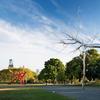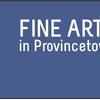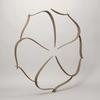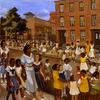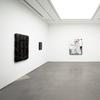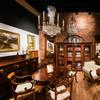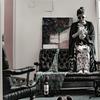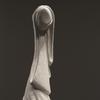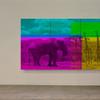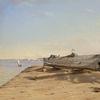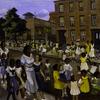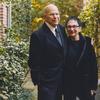highwatermarks—six ways of sensing the river, Dylan Gauthier Artistic Residency, June 2016 - July 2017
- CHADDS FORD, Pennsylvania
- /
- October 06, 2016
A new sculptural installation on display in the museum’s second floor atrium is getting as much attention as the spectacular view. Hydrologic Unity: 02040205 is a brightly-painted, two-person boat built in June by Dylan Gauthier, the Museum’s first artist-in-residence, with assistance from local volunteers. Gauthier is using the community-built boat to explore the fabled Brandywine, depicted in art by painters, and the source of drinking water for close to half-a-million area residents. Look for him and the boat on the river or in the museum or in his next project observationhouse, on view starting October 17. observationhouse is a temporary and moveable structure Gauthier has designed, built, placed on the riverbank near the Museum, which the community is invited to explore.
These are the first two artworks created by Gauthier during his year-long collaboration with the Brandywine Conservancy & Museum of Art. highwatermarks—six ways of sensing the river is a participatory, community-based artistic project focused on the Brandywine River and the place of water in the public's shared imagination. Gauthier is creating a stimulating dialogue between art and the nature, and between the Conservancy’s acclaimed group of scientists and planners, and the Museum’s curators and educators.
The numbers in the title Hydrologic Unity: 02040205 refer to the precise location of the Brandywine River using a system created by the United States Geological Survey (USGS). The Brandywine is within the Mid-Atlantic water-resources region (02), the Delaware sub-region (04), the Lower Delaware accounting unit (02), and finally, within the watersheds of the Brandywine-Christina rivers (05). It also makes a play on the words “unit” and “unity,” echoed in Gauthier’s accompanying neon piece, which speaks to the Brandywine as a connector of the diverse populations of the surrounding region. As the punt is used, the original colors will wear away to reveal other colors beneath them.
The second part of highwatermarks, titled observationhouse, is an outdoor sculptural installation and mobile field studio that will serve as Gauthier’s workspace and as place for him to interact with the community during his residency. observationhouse will function as a studio for art-work and experimentation. It is equipped with environmental sensing technologies, a weather station, water quality monitoring instruments, and live data from the nearby USGS shed.
Gauthier and a team of fabricators will construct observationhouse on the Museum’s riverbank the week of October 10 to 15. Starting Monday, October 17 through Sunday, October 30, Gauthier will lead the public on silent, listening walks each morning at 10 a.m. to various conservancy land sites culminating with a discussion in observationhouse.
Each afternoon at 2 p.m. during these two weeks, Gauthier will conduct interviews inside observationhouse with Conservancy staff and local conservationists about topics such as the role of observation, engagement, experiential learning, and direct encounters with the landscape in their work. The public is invited to listen to and observe these conversations.
Throughout November and December, Gauthier will work on-site periodically, welcoming visitors into observationhouse. When he is not on-site, observationhouse will be open daily and the public is invited to observe the landscape and experience Gauthier’s sound recordings, interviews, and river data from October. observationhouse will remain on the riverbank of the Museum campus until January 5, 2017.
Dylan Gauthier is an artist, curator, and writer whose work explores ecology, architecture, collectivity, time, media and networks, utopian systems, as well as questions an artist’s role in society. He teaches art and media studies at Hunter College of the City University of New York.
“My artwork engages with ecology and the relationships between waterways and their surrounding communities,” said Gauthier. “Regional waterways were once the lifeblood of cities and towns across the country. Rivers powered industry, acted as a connective fabric between distinct communities and were a source of food, drinking water, transportation and recreation. I am inspired by the work that the Brandywine Conservancy is doing in local watersheds to help ensure cleaner drinking water and raise awareness of the fragility of area waterways.”
“Dylan is a fascinating artist whose work includes sculptural, conceptual, video and performative elements. I am thrilled that his residency will focus on the extraordinary activities of our colleagues at the Conservancy, in particular their efforts to protect the Brandywine watershed,” said Thomas Padon, Museum director.
The Brandywine River Museum of Art features an outstanding collection of American art housed in a 19th-century mill building with a dramatic steel and glass addition overlooking the banks of the Brandywine. The Museum is open daily (except Thanksgiving Day and Christmas Day) from 9:30 a.m. to 5 p.m. Admission is $15 for adults, $10 for seniors ages 65 and over, $6 for students and children ages 6 to 12; free for children 5 and younger and members. The museum is located on Route 1 in Chadds Ford, Pennsylvania. For more information, call 610.388.2700 or visit brandywinemuseum.org.
# # #
Contact:
Hillary HollandBrandywine River Museum of Art
6103888336
hholland@brandywine.org
PO Box 141
Brandywine River Museum of Art, Pennsylvania
hholland@brandywine.org
610-388-2700
http://www.brandywine.org/museum

